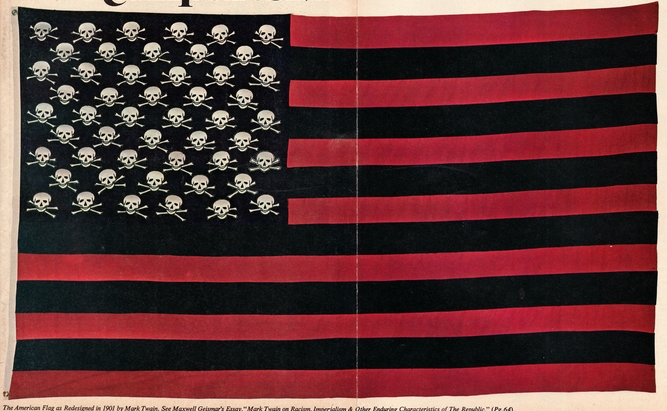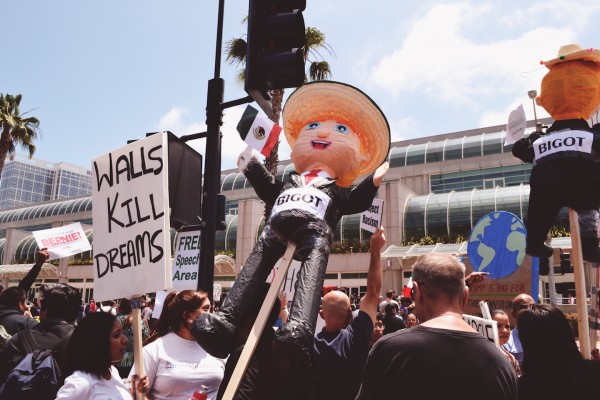“[America] goes not abroad in search of monsters to destroy…. She well knows that by once enlisting under other banners than her own, were they even the banners of foreign independence, she would involve herself, beyond the power of extrication, in all the wars of interest and intrigue, of individual avarice, envy, and ambition, which assume the colors and usurp the standard of freedom. The fundamental maxims of her policy would insensibly change from liberty to force. The frontlet upon her brows would no longer beam with the ineffable splendor of freedom and independence; but in its stead would soon be substituted an imperial diadem, flashing in false and tarnished lustre the murky radiance of dominion and power. She might become the dictatress of the world: she would be no longer the ruler of her own spirit.”[1]
– John Quincy Adams, July 4, 1821
“…we can have just our usual flag, with the white stripes painted black and the stars replaced with the skull and cross-bones.”[2] (See accompanying picture.)
– Mark Twain, regarding the U.S. conquest of the Philippines in 1899
***
The following list was compiled by the Congressional Research Service, and published under the title Instances of Use of United States Forces Abroad, 1798-2015.[3] (It’s updated every few years.) Richard F. Grimmett, retired CRS specialist in International Security, was the original author of this report. The report has since been updated by the current author, Barbara Salazar Torreon, Analyst in Defense Budget and Military Manpower.
As this list shows, the United States has invaded other countries hundreds of times. It’s interesting to note, however, that it has declared war only 11 times.
From the Summary:
“Eleven times in its history, the United States has formally declared war against foreign nations. These 11 U.S. war declarations encompassed five separate wars: the war with Great Britain declared in 1812; the war with Mexico declared in 1846; the war with Spain declared in 1898; the First World War, during which the United States declared war with Germany and with Austria-Hungary during 1917; and World War II, during which the United States declared war against Japan, Germany, and Italy in 1941, and against Bulgaria, Hungary, and Rumania in 1942.”
Here’s a list of the invasions during the 1800s, copied verbatim from the Congressional Research Service report, which is in the public domain. Remember, this is an official U.S. government history, so naturally every invasion is described as a benevolent venture to “protect American interests,” etc.
***
1798-1800
Undeclared Naval War with France. This contest included land
actions, such as that in the Dominican Republic, city of Puerto Plata,
where marines captured a French privateer under the guns of the forts.
Congress authorized military action through a series of statutes.
1801-05
Tripoli. The First Barbary War included the U.S.S. George
Washington and Philadelphia affairs and the Eaton expedition, during
which a few marines landed with United States Agent William Eaton
to raise a force against Tripoli in an effort to free the crew of the
Philadelphia. Tripoli declared war but not the United States,
although Congress authorized U.S. military action by statute.
1806
Mexico (Spanish territory). Capt. Z. M. Pike, with a platoon of
troops, invaded Spanish territoryat the headwaters of the Rio Grande
on orders from Gen. James Wilkinson. He was made prisoner
without resistance at a fort he constructed in present day Colorado,
taken to Mexico, and later released after seizure of his papers.
1806-10
Gulf of Mexico. American gunboats operated from New Orleans
against Spanish and French privateers off the Mississippi Delta,
chiefly under Capt. John Shaw and Master Commandant David
Porter.
1810
West Florida (Spanish territory). Gov. Claiborne of Louisiana, on
orders of the President, occupied with troops territory in dispute east
of the Mississippi River as far as the Pearl River, later the eastern
boundary of Louisiana. He was authorized to seize as far east as the
Perdido River.
1812
Amelia Island and other parts of east Florida, then under Spain.
Temporary possession was authorized by President Madison and by
Congress, to prevent occupation by any other power; but possession
was obtained by Gen. George Matthews in so irregular a manner that
his measures were disavowed by the President.
1812-15
War of 1812. On June 18, 1812, the United States declared war
between the United States and the United Kingdom of Great
Britain and Ireland. Among the issues leading to the war were
British interception of neutral ships and blockades of the United
States during British hostilities with France.
1813
West Florida (Spanish territory). On authority given by Congress,
General Wilkinson seized Mobile Bay in April with 600 soldiers. A
small Spanish garrison gave way. The U.S. advanced into disputed
territory to the Perdido River, as projected in 1810. No fighting.
1813-14
Marquesas Islands. U.S. forces built a fort on the island of Nukahiva
to protect threeprize ships which had been captured from the British.
1814
Spanish Florida.Gen. Andrew Jackson took Pensacola and drove out
the British with whom the United States was at war.
1814-25
Caribbean. Engagements between pirates and American ships or
squadrons took place repeatedly especially ashore and offshore about
Cuba, Puerto Rico, Santo Domingo, and Yucatan. Three thousand
pirateattacks on merchantmen were reported between 1815 and 1823.
In 1822 Commodore James Biddle employed a squadron of two
frigates, four sloops of war, two brigs, four schooners, and two
gunboats in the West Indies.
1815
Algiers. The second Barbary War was declared against the United
States by the Dey of Algiers of the Barbary states, an act not
reciprocated by the United States. Congress did authorize a military
expedition by statutes. A large fleet under Decatur attacked Algiers
and obtained indemnities.
1815
Tripoli. After securing an agreement from Algiers, Decatur
demonstrated with his squadron at Tunis and Tripoli, where he
secured indemnities for offenses during the War of 1812.
1816
Spanish Florida. United States forces destroyed Nicholls Fort, called
also Negro Fort, which harbored raiders making forays into United
States territory.
1816-18
Spanish Florida – First Seminole War. The Seminole Indians, whose
area was a haven for escaped slaves and border ruffians, were
attacked by troops under Generals Jackson and Gaines and pursued
into northern Florida. Spanish posts were attacked and occupied,
British citizens executed. In 1819 the Floridas were ceded to the
United States.
1817
Amelia Island (Spanish territory off Florida). Under orders of
President Monroe, United States forces landed and expelled a group
of smugglers, adventurers, and freebooters.
1818
Oregon. The U.S.S. Ontario, dispatched from Washington, landed
at the Columbia River and in August took possession of Oregon
territory. Britain had conceded sovereignty but Russia and Spain
asserted claims to the area.
1820-23
Africa. Naval units raided the slave traffic pursuant to the 1819 act
of Congress.
1822
Cuba. United States naval forces suppressing piracy landed on the
northwest coast of Cuba and burned a pirate station.
1823
Cuba. Brief landings in pursuit of pirates occurred April 8 near
Escondido; April 16 near Cayo Blanco; July 11 at Siquapa Bay; July
21 at Cape Cruz; and October 23 at Camrioca.
1824
Cuba. In October the U.S.S. Porpoise landed bluejackets near
Matanzas in pursuit of pirates. This was during the cruise authorized
in 1822.
1824
Puerto Rico (Spanish territory). Commodore David Porter with a
landing party attacked the town of Fajardo which had sheltered
pirates and insulted American naval officers. He landed with 200
men in November and forced an apology. Commodore Porter was
later court-martialed for overstepping his powers.
1825
Cuba. In March cooperating American and British forces landed at
Sagua La Grande to capture pirates.
1827
Greece. In October and November landing parties hunted pirates on
the islands of Argenteire, Miconi, and Androse.
1831-32
Falkland Islands.
Captain Duncan of the U.S.S. Lexington investigated the capture of three American sailing vessels and sought to protect American interests.
1832
Sumatra. February 6 to 9. A naval force landed and stormed a fort to
punish natives of the town of Quallah Battoo for plundering the
American ship Friendship.
1833
Argentina. October 31 to November 15. A force was sent ashore at
Buenos Aires to protect the interests of the United States and other
countries during an insurrection.
1835-36
Peru. December 10, 1835, to January 24, 1836, and August 31 to
December 7, 1836. Marines protected American interests in Callao
and Lima during an attempted revolution.
1836
Mexico. General Gaines occupied Nacogdoches (Tex.), disputed
territory, from July to December during the Texan war for
independence, under orders to cross the “imaginary boundary line” if
an Indian outbreak threatened.
1838-39
Sumatra. December 24, 1838, to January 4, 1839. A naval force
landed to punish natives of the towns of Quallah Battoo and Muckie
(Mukki) for depredations on American shipping.
1840
Fiji Islands.July. Naval forces landed topunish natives for attacking
American exploring and surveying parties.
1841
Drummond Island, Kingsmill Group. A naval partylanded to avenge
the murder of a seaman by the natives.
1841
Samoa. February 24. A naval partylanded and burned towns after the
murder of an American seaman on Upolu Island.
1842
Mexico. Commodore T.A.C. Jones, in command of a squadron long
cruising off California, occupied Monterey, Calif., on October 19,
believing war had come. He discovered peace, withdrew, and
saluted. A similar incident occurred a week later at San Diego.
1843
China. Sailors and marines from the St. Louis were landed after a
clash between Americans and Chinese at the trading post in Canton.
1843
Africa. November 29 to December 16. Four United States vessels
demonstrated and landed various parties (one of 200 marines and
sailors) to discourage piracy and the slave trade along the Ivory coast,
and to punish attacks by the natives on American seamen and
shipping.
1844
Mexico. President Tyler deployed U.S. forces to protect Texas
against Mexico, pending Senate approval of a treaty of annexation.
(Later rejected.) He defended his action against a Senate resolution
of inquiry.
1846-48
Mexican War. On May 13, 1846, the United States recognized
the existence of a state of war with Mexico. After the annexation of
Texas in 1845, the United States and Mexico failed to resolve a
boundary dispute and President Polk said that it was necessary to
deploy forces in Mexico to meet a threatened invasion.
1849
Smyrna. In July a naval force gained release of an American seized
by Austrian officials.
1851
Turkey. After a massacre of foreigners (including Americans) at Jaffa
in January, a demonstration by the Mediterranean Squadron was
ordered along the Turkish (Levant) coast.
1851
Johanns Island (east of Africa). August. Forces from the U.S. sloop
of war Dale exacted redress for the unlawful imprisonment of the
captain of an American whaling brig.
1852-53
Argentina.February3 to 12, 1852; September 17, 1852 to April 1853.
Marines were landed and maintained in Buenos Aires to protect
American interests during a revolution.
1853
Nicaragua. March 11 to 13. U.S. forces landed to protect American
lives and interests during political disturbances.
1853-54
Japan. Commodore Perry and his naval expedition made a display
of force leading to the “opening of Japan.”
1853-54
Ryukyu and Bonin Islands. Commodore Perry on three visits before
going to Japan and whilewaitingfor a replyfrom Japan made a naval
demonstration, landing marines twice, and secured a coaling
concession from the ruler of Naha on Okinawa; he also demonstrated
in the Bonin Islands with the purpose of securing facilities for
commerce.
1854
China. April 4 to June 15 to 17. American and English ships landed
forces to protect American interests in and near Shanghai during
Chinese civil strife.
1854
Nicaragua. July 9 to 15. Naval forces bombarded and burned San
Juan del Norte (Greytown) to avenge an insult to the American
Minister to Nicaragua.
1855
China. May 19 to 21. U.S. forces protected American interests in
Shanghai and, from August 3 to 5 fought pirates near Hong Kong.
1855
Fiji Islands. September 12 to November 4. An American naval force
landed to seek reparations for depredations on American residents
and seamen.
1855
Uruguay. November 25 to 29. United States and European naval
forces landed to protect American interests during an attempted
revolution in Montevideo.
1856
Panama, Republic of New Grenada. September 19 to 22. U.S. forces
landed to protect American interests during an insurrection.
1856
China. October 22 to December 6. U.S. forces landed to protect
American interests at Canton during hostilities between the British
and the Chinese, and to avenge an assault upon an unarmed boat
displaying the United States flag.
1857
Nicaragua. April to May, November to December. In May
Commander C.H. Davis of the United States Navy, with some
marines, received the surrender of William Walker, who had been
attempting to get control of the country, and protected his men from
the retaliation of native allies who had been fighting Walker. In
November and December of the same year United States vessels
Saratoga, Wabash, and Fulton opposed another attempt of William
Walker on Nicaragua. Commodore Hiram Paulding’s act of landing
marines and compelling the removal of Walker to the United States,
was tacitly disavowed by Secretary of State Lewis Cass, and Paulding
was forced into retirement.
1858
Uruguay. January 2 to 27. Forces from two United States warships
landed to protect American property during a revolution in
Montevideo.
1858
Fiji Islands. October 6 to 16. A marine expedition chastised natives
for the murder of two American citizens at Waya.
1858-59
Turkey. The Secretary of State requested a display of naval force
along the Levant after a massacre of Americans at Jaffa and mistreat-
ment elsewhere “to remind the authorities (of Turkey) of the power
of the United States.”
1859
Paraguay. Congress authorized a naval squadron to seek redress for
an attack on a naval vessel in the Parana River during 1855.
Apologies were made after a large display of force.
1859
Mexico. Two hundred United States soldiers crossed the Rio Grande
in pursuit of the Mexican bandit Cortina.
1859
China. July 31 to August 2. A naval force landed to protect
American interests in Shanghai.
1860
Angola, Portuguese West Africa. March 1. American residents at
Kissembo called upon American and British ships to protect lives and
property during problems with natives.
1860
Colombia (Bay of Panama). September 27 to October 8. Naval forces
landed to protect American interests during a revolution.
1863
Japan. July16. The U.S.S. Wyoming retaliated against afiring on the
American vessel Pembroke at Shimonoseki.
1864
Japan. July14 to August 3. Naval forces protected the United States
Minister to Japan when he visited Yedo to negotiate concerning some
American claims against Japan, and to make his negotiations easier
by impressing the Japanese with American power.
1864
Japan. September 4 to 14. Naval forces of the United States, Great
Britain, France, and the Netherlands compelled Japan and the Prince
of Nagato in particular to permit the Straits of Shimonoseki to be
used by foreign shipping in accordance with treaties already signed.
1865
Panama. March 9 and 10. U.S. forces protected the lives and
property of American residents during a revolution.
1866
China. From June 20 to July 7, U.S. forces punished an assault on
the American consul at Newchwang.
1866
Mexico. To protect American residents, General Sedgwick and 100
men in November obtained surrender of Matamoras. After threedays
he was ordered by U.S. Government to withdraw. His act was
repudiated by the President.
1867
Nicaragua. Marines occupied Managua and Leon.
1867
Formosa. June 13. A naval force landed and burned a number of
huts to punish the murder of the crew of a wrecked American vessel.
1868
Japan (Osaka, Hiolo, Nagasaki, Yokohama, and Negata). February
4 to 8, April 4 to May 12, June 12 and 13. U.S. forces were landed
to protect American interests during the civil war in Japan.
1868
Uruguay. February 7 and 8, 19 to 26. U.S. forces protected foreign
residents and the customhouse during an insurrection at Montevideo.
1868
Colombia. April. U.S. forces protected passengers and treasure in
transit at Aspinwall during the absence of local police or troops on
the occasion of the death of the President of Colombia.
1870
Mexico. June 17 and 18. U.S. forces destroyed the pirate ship
Forward, which had been run aground about 40 miles up the Rio
Tecapan.
1870
Hawaiian Islands. September 21. U.S. forces placed the American
flag at half mast upon the death of Queen Kalama, when the
American consul at Honolulu would not assume responsibility for so
doing.
1871
Korea. June 10 to 12. A U.S. naval force attacked and captured five
forts to punish natives for depredations on Americans, particularly for
murdering the crew of the General Sherman and burning the
schooner, and for later firing on other American small boats taking
soundings up the Salee River.
1873
Colombia (Bay of Panama). May 7 to 22, September 23 to
October 9. U.S. forces protected American interests during hostilities
between local groups over control of the government of the State of
Panama.
1873-96
Mexico. United States troops crossed the Mexican border repeatedly
in pursuit of cattle thieves and other brigands. There were some
reciprocal pursuits by Mexican troops into border territory. Mexico
protested frequently. Notable cases were at Remolina in May 1873
and at Las Cuevas in 1875. Washington orders often supported these
excursions. Agreements between Mexico and the United States, the
first in 1882, finally legitimized such raids. They continued
intermittently, with minor disputes, until 1896.
1874
Hawaiian Islands. February 12 to 20. Detachments from American
vessels were landed to preserve order and protect American lives and
interests during the coronation of a new king.
1876
Mexico. May 18. An American force was landed to police the town
of Matamoras temporarily while it was without other government.
1882
Egypt. July 14 to 18. American forces landed to protect American
interests during warfare between British and Egyptians and lootingof
the city of Alexandria by Arabs.
1885
Panama (Colon). January18 and 19. U.S. forces were used to guard
the valuables in transit over the Panama Railroad, and the safes and
vaults of the company during revolutionary activity. In March, April,
and May in the cities of Colon and Panama, the forces helped
reestablish freedom of transit during revolutionary activity.
1888
Korea. June. A naval force was sent ashore to protect American
residents in Seoul during unsettled political conditions, when an
outbreak of the populace was expected.
1888
Haiti. December 20. A display of force persuaded the Haitian
Government to give up an American steamer which had been seized
on the charge of breach of blockade.
1888-89
Samoa. November 14, 1888, to March 20, 1889. U.S. forces were
landed to protect American citizens and the consulate during anative
civil war.
1889
Hawaiian Islands. July 30 and 31. U.S. forces protected American
interests at Honolulu during a revolution.
1890
Argentina. A naval party landed to protect U.S. consulate and
legation in Buenos Aires.
1891
Haiti. U.S. forces sought to protect American lives and property on
Navassa Island.
1891
Bering Strait. July 2 to October 5. Naval forces sought to stop seal
poaching.
1891
Chile. August 28 to 30. U.S. forces protected the American
consulate and the women and children who had taken refuge in it
during a revolution in Valparaiso.
1893
Hawaii. January 16 to April 1. Marines were landed ostensibly to
protect American lives and property, but many believed actually to
promote a provisional government under Sanford B. Dole. This
action was disavowed by the United States.
1894
Brazil. January. A displayof naval force sought to protect American
commerce and shipping at Rio deJaneiro during a Brazilian civil war.
1894
Nicaragua. July 6 to August 7. U.S. forces sought to protect
American interests at Bluefields following a revolution.
1894-95
China. Marines were stationed at Tientsin and penetrated to Peking
for protection purposes during the Sino-Japanese War.
1894-95
China. A naval vessel was beached and used as a fort at Newchwang
for protection of American nationals.
1894-96
Korea. July 24, 1894 to April 3, 1896. A guard of marines was sent
to protect the American legation and American lives and interests at
Seoul during and following the Sino-Japanese War.
1895
Colombia. March 8 to 9. U.S. forces protected American interests
during an attack on the town of Bocas del Toro by a bandit chieftain.
1896
Nicaragua. May 2 to 4. U.S. forces protected American interests in
Corinto during political unrest.
1898
Nicaragua. February 7 and 8. U.S. forces protected American lives
and property at San Juan del Sur.
1898
The Spanish-American War. On April 25, 1898, the United
States declared war with Spain. The war followed a Cuban
insurrection against Spanish rule and the sinking of the U.S.S. Maine
in the harbor at Havana.
1898-99
China. November 5, 1898 to March 15, 1899. U.S. forces provided
a guard for the legation at Peking and the consulate at Tientsin during
contest between the Dowager Empress and her son.
1899
Nicaragua. Americanand British naval forces were landed to protect
national interests at San Juan del Norte, February 22 to March 5, and
at Bluefields a few weeks later in connection with the insurrection of
Gen. Juan P. Reyes.
1899
Samoa. February-May 15. American and British naval forces were
landed to protect national interests and to take part in a bloody
contention over the succession to the throne.
1899-1901 Philippine Islands. U.S. forces protected American interests
following the war with Spain and conquered the islands by defeating
the Filipinos in their war for independence.
[To be continued…]
SOURCES
[1] theamericanconservative.com
[2] loc.gov
[3] fas.org



















